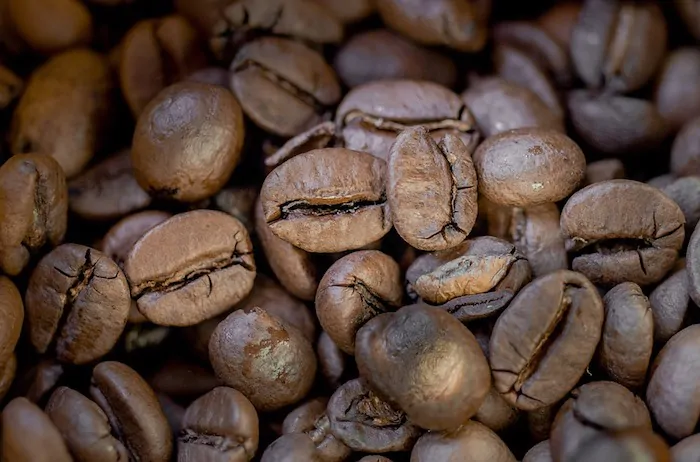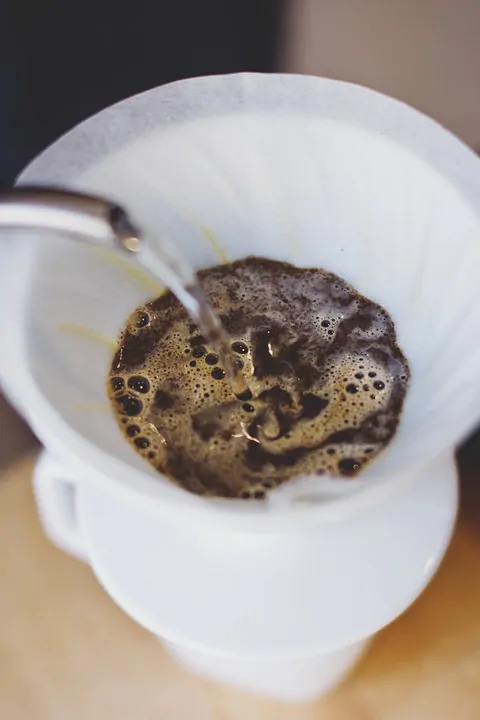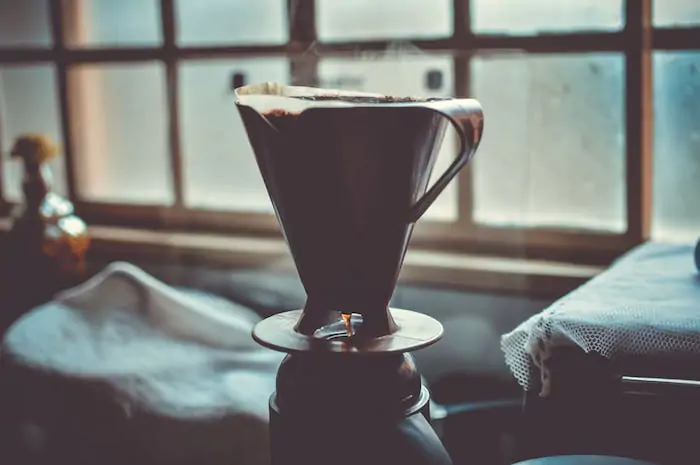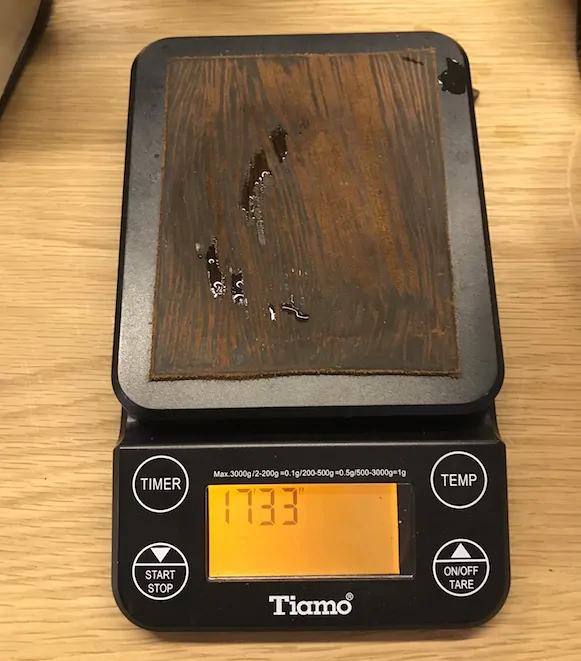Coffee enthusiasts consider even the tiniest of details such as the type of coffee beans to use. Can you make pour over coffee with espresso beans? Here is an insight

A regular cup of pour-over coffee is different from a shot of espresso. Now, you may be wondering why they are different. I mean they are both coffee, and ideally, both can be made from the same coffee beans.
But, can you make your pour-over coffee using espresso beans? Technically, yes. You can use espresso-roasted beans to make your pour-over coffee because there is not much difference between espresso and coffee beans.
The major difference comes out in the bean preparation. Coffee beans meant for espresso are roasted for a longer time compared to those meant for drip coffee. Additionally, espresso beans are ground into a finer powder, more like sand than gravel.
However, they are both the same. Labeling the beans as drip or espresso is simply the roaster’s recommendation for bringing out the specific flavor intended.
That said, you need to learn the difference between espresso and pour over coffee, how to make pour over coffee, the different techniques as well as devices used to make it. Read on for a deeper insight into this.
- What Is The Difference Between Coffee And Espresso?
- What Is Pour Over Coffee?
- Why Would Anyone Use The Pour Over Method?
- What Equipment Is Needed For Pour Over Coffee?
- Which Coffee Beans Are Ideal For Pour Over Coffee?
- A Guide For Brewing Pour Over Coffee
- Tips To Help You Nail The Perfect Pour Over Brew
- Can You Make Pour Over Coffee With Espresso Beans Related Questions
What Is The Difference Between Coffee And Espresso?
If you order an espresso and you are handed black coffee and vice versa, you are going to be disappointed. Although they are both made from the same coffee beans, as already said, there is a difference in the preparation method. However, the type of beans used is important in achieving that taste/flavor.
Espresso is a strong black coffee made by forcing extremely hot water through tightly packed grounds. The extraction process gives it the signature layers, which include a crema or a small layer of foam at the top, and a shot of coffee at the bottom. To make the perfect espresso, you need the right gear, which is the espresso machine
For drip coffee, you have a few options for brewing. The ground can be a little coarse than that of espresso because you are going to be mixing it with water for a longer time. For brewing, you could either use the drip or pour-over method, or you can go the immersion way like in a French press.
Whichever way, the coffee will have a milder flavor compared to espresso, and you will not have any crema.
Generally, the process of preparation has everything to do with differentiating brewed coffee and espresso. This is what brings out the different flavors, but the right style of beans can also set aside an ok cup from an extraordinary one.
What Is Pour Over Coffee?

In recent years, pour over coffee has become popular, and coffee lovers are enthusiastic about knowing the techniques and tools to use.
The pour-over method of coffee making involves pouring hot water through the grounds in a filter. You then let the water drain through the grounds in a filter into a mug or carafe. This method is also called manual brewing or hand brewing because it involving practically pouring the water over the coffee by hand.
If you love pour-over coffee, you might find out guide on the best coffee grinders for pour-over coffee helpful.
Why Would Anyone Use The Pour Over Method?
The pour-over method is known to bring out intricate flavors, which you can hardly achieve with the other brewing methods. This makes it the most preferred choice, especially for single-origin coffees, as it accentuates the aromas and flavors.
Additionally, filter coffee is clear, clean, and consistent. The water extracts the fragrances and coffee oils at its own consistent time and pressure. The filter catches the oils, yield a clean cup of coffee.
And, of course, this is an infusion method, thus more efficient in the extraction of coffee solubles compared to the immersion techniques like the French press. Immersion methods lead to water saturation whereas pour overuses a regular supply of fresh water.
However, this method may not be smooth sailing all through. It has its challenges too because any manual method is subject to human error. For instance, there is a risk of channeling if a water stream finds a weak passage around the ground coffee.
This is more likely if the coffee clumps or grounds are distributed unevenly. Thus, you must learn to pour in such a way that the grounds are immersed evenly in the water.
What Equipment Is Needed For Pour Over Coffee?
When it comes to the pour-over technique, there are many options for equipment to use. for starters, you could use just a simple device with some filters, and add more equipment as you advance. Below is a guide on the basic equipment needed for pour over coffee.
- Brewing Devices

A brewing device like this is also known as the dripper. It is the part holding the grounds and the filter. Some of the popular choices are the V60m Melitta and Kalita Wave 185.
These three sit on the coffee mug or carafe, but they all have distinct design features that affect the flow and extraction.
Nevertheless, they are all adaptable and easy to use. For brewing coffee at home, you can use any of them but for a specialty coffee shop, experiment with all the three, and then choose the one most preferred by the barristers.
- Filters
There is a little debate when it comes to the type of filters to use. We have cloth and paper bleached and unbleached. Some filters can fit in just about device.
The Chemex filter, for instance, is 20-30% heavier than the other filters in a bid to retain more oil during the brewing process.
For paper filers, some claim that they may emit an undesired papery taste, especially if they are bleached. However, you can counter this effect by rinsing it before use. Cloth filters, on the other hand, have been popular for a long, mainly because they do not affect the flavor.
The choice is yours, but whichever filter you choose, ensure that it properly fits on your device to maintain a consistent extraction.
- Coffee Scales

To make perfect pour-over coffee, you need to ensure that everything is in the right measurements. Get a digital scale to measure your water and coffee. This way, you can replicate certain measurements if the coffee turns out good, or tweak it for even better results.
- Kettles
You have probably seen specialty barristers pouring water from small copper kettles. That kettle keeps the water at a stable temperature, thus bringing out consistency in extraction. You may not use the exact kettle at home, but whichever you use, ensure that you are watching the temperature for consistency purposes.
A slow-pouring kettle with a long neck would be perfect for the job.
Which Coffee Beans Are Ideal For Pour Over Coffee?
With the pour-over method, you have control over the brewing process, with which you can bring out the desirable flavors and characteristics of your coffee. However, it is still important to use the right type of coffee. There are three factors to consider including the roast, the grind, and the country of origin.
- The Roast
With the control you have in this process, you should choose the level of roast that you desire. You can get dark, medium, espresso, or light roast. Darker roasts contain less caffeine than lighter roasts.
The lighter roasts are also less bitter, and the environment in the region where it is grown influences their flavor. Darker roasts, on the other hand, obtain their flavor during the roasting process.
In certain brewing methods, you may lose the flavors in light or medium roasts. However, the pour-over method retains all flavors regardless of your selected roast level. Thus, as long as you chose one that appeals to you, you will still make a delicious cup of coffee.
- Country of Origin
Now that you have the roast level, it is time to choose the actual coffee considering the country of origin. The United States, specifically Kona coffee from the Big Island of Hawaii is known for its subtle undertones, which accentuate the pour-over coffee brewing technique. It is smooth with many flavors.
The Mexican coffee is balanced, but it has a certain flavor that can be lost when brewing. However, you can retain it through pour over brewing method.
Then, there is the Guatemala coffee popular for its rich flavor. To enjoy this flavor, you need to use the pour over method to ensure the flavor remains.
- Grind Size
The rate of extraction is affected by the size of your grounds. Since pour over uses the infusion method, the water and coffee get in contact for a short time. Thus, you need sufficient surface area to enable maximum extraction right before the water filters into the carafe or cup.
However, it should not be so much that it would over-extract and produce a bitter brew. The best thing to do is to start with medium grind size. If it becomes too watery, try a finer grind. If it lacks some sweet notes or is too bitter, make it a little coarser.
With a quality grinder (see reviews), your particle size should be even and consistent, producing a great cup of pour-over coffee.

A Guide For Brewing Pour Over Coffee
For pour-over coffee, we may not have any standardized set of instructions that are ideal for every situation. Every cup you brew is going to be unique and some may be better than others may. Below are the basic instructions to follow.
- Gather Your Equipment
Get all the needed equipment including a pour-over coffee maker, coffee grinder, kitchen scale, a carafe, cup, or tumbler, and an electric or stovetop kettle.
- Choose Your Beans
You will first decide what kind of coffee beans you will want to use. this one is entirely up to you. You can consult with a barista or smell around every coffee at the shop until you find one that appeals to you.
- Weigh the Coffee
You need to determine how much coffee you need considering the water to coffee ratio. Most barristers recommend 18 grams of water for every gram of coffee. This balances in between 9 and 11 grams of coffee for every cup of 6 ounces of water. Generally, more coffee=more flavor.
Use your scale to weigh and get the exact measurement for everything used. This way you can know whether you need to adjust it for an even better flavor.
- Grind the Coffee Beans
Grinding your beans right before brewing gives you the upper hand over the flavor. For pour over coffee, a medium-fine to medium-coarse grind almost the texture of sea salt or sand is the most appropriate. A finer grind could yield more flavor but it may give some bitterness.
A coarse grind yields a sweeter coffee but it may be under-extracted, thus weak. Just find your happy medium. If you want it milder, make the grind coarser. If you want it richer, make it coarser.
- Prepare Your Filter
Most people use paper filters for their pour-overs. These filters come in different fineness, thus, you need to find the right size. If you feel some paper taste in your final coffee, then you should make a habit of rinsing your filter paper before using it.
However, if you have no problem with the paper taste, or if you never feel it, go ahead and use it without rinsing.
To rinse properly, put your brewer in the dripper and pour water around it in circles to rinse the filter. The rinse water will gather in the carafe or cup; ensure to discard all of it. Once your filter is ready, pour your freshly ground coffee in it.
- Heat Your Water
Heat your water between 195-205 degrees Fahrenheit. If you do not have a thermometer to measure the exact temperature, simply let the water boil, remove it from heat, and give it 30 seconds before using it in your brew. If you have a smart electric kettle, you can set the desired temperature and it will maintain it, that way until you are ready to use the water.

- Set Up To Brew
Now as your water boils, set up your cup/carafe/tumbler on the scale. Put your grounds in the filter and set the scale to zero. This is to ensure you know how much water you will be pouring. For starters, you can use the 17:1 grams ratio and tweak it from there.
- Bloom the Grounds
Once you have everything ready from hot water, ground coffee, and a rinsed filter, it is now time to bloom. Here, you simply wet the coffee grounds evenly with just enough water to saturate and nothing more. Wait and let the gases bubble out for like a minute.
Blooming is crucial as it prepares the way for the final pour to maneuver the grounds uniformly. For this step and the next one, it is recommendable to use the Gooseneck kettle like this. This way you will be in control of the speed and precision of water.
- Pour the Water
You will begin this step around 30 seconds after blooming. Use your gooseneck kettle to pour water slowly in a circular motion, while keeping the spout close to the grounds. This pouring technique is what differentiates the pour-over method from other drip brewers.
Now your pour-over brew is ready, and it is time to taste.do the tasting before adding any extras so that you can decide whether it is how you like it. Note the flavor and strength. This way you can decide whether you need to change or add anything in your future brews.
Tips To Help You Nail The Perfect Pour Over Brew
The pour over method may seem simple, but with the tips below, you will make the perfect brew.
- Always remember to wet or bloom. When you grind your coffee beans, there is a build-up of carbon dioxide. While this may not necessarily be a bad thing, it will hinder the water from penetrating the grinds properly. Thus, you need to bloom first for 30 seconds to get rid of it.
- Remember to be consistent and keep a record on your way to perfecting the skill of brewing good pour-over coffee. Do this by using a quality burr grinder and a concise scale. Additionally, closely follow a brewing guide.
- Always use the pour-over coffee ratio already discussed above.
- Always get the grind size right. A medium-size would be ideal.
- The water temperature matters a lot. If you do not have a thermometer to measure between 195 and 205 degrees Fahrenheit, boil the water and let it off the heat for 30 seconds before brewing. Remember to use clean water.
- Perfect your pour. Pour in slow and steady spirals so that everything is even. A gooseneck kettle is ideal to help you with precision.
- Always keep your brewing equipment clean and free of coffee oils. Let the pour-over tool cool before cleaning it to avoid damage from sudden changes in temperature.
Can You Make Pour Over Coffee With Espresso Beans Related Questions
Can you use just any coffee for espresso?
Most people have come to believe that the type of beans used will determine whether it is an espresso or not. This is not true because any type of beans can be used. You can still have a great espresso using the normal coffee beans.
The only variation is that those ground specifically for espresso is stronger according to the roasters.
Are there any other drip brewing methods?
The pour-over coffee brewing method is one among many drip-brewing tools available. We also have the automatic drip brewer, which showers hot water over the grounds with a stationary head. Chemex and Percolators also use this technique.
Do you need to get all the equipment to make pour-over coffee?
Ideally, you can brew pour-over coffee with just a regular kettle and no scale and still get a good brew. The problem is that you will not have consistency in your brew whenever you are brewing if control and consistency are not a problem for you, you can go right ahead and make your brew with whatever tools you can get.
For More: CAN YOU USE A PAPER TOWEL AS A COFFEE FILTER? (FILTER SUBSTITUTE
